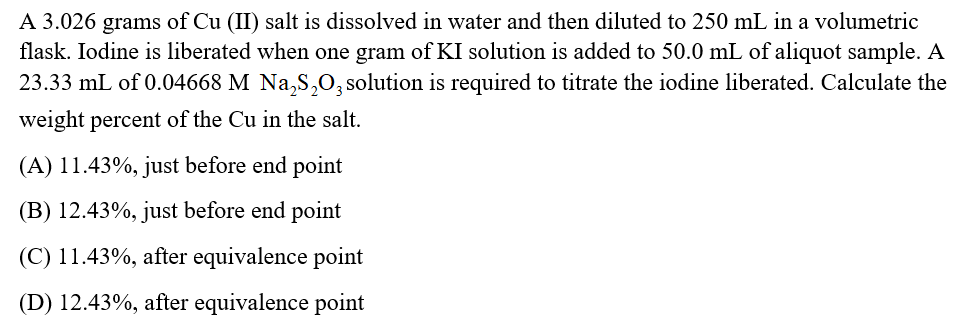A 3.026 grams of Cu (II) salt is dissolved in water and then diluted to 250 mL in a volumetric flask. Iodine is liberated when one gram of KI solution is added to 50.0 mL of aliquot sample. A 23.33 mL of 0.04668 M Na,S,O, solution is required to titrate the iodine liberated. Calculate the weight percent of the Cu in the salt. (A) 11.43%, just before end point (B) 12.43%, just before end point (C) 11.43%, after equivalence point (D) 12.43%, after equivalence point
A 3.026 grams of Cu (II) salt is dissolved in water and then diluted to 250 mL in a volumetric flask. Iodine is liberated when one gram of KI solution is added to 50.0 mL of aliquot sample. A 23.33 mL of 0.04668 M Na,S,O, solution is required to titrate the iodine liberated. Calculate the weight percent of the Cu in the salt. (A) 11.43%, just before end point (B) 12.43%, just before end point (C) 11.43%, after equivalence point (D) 12.43%, after equivalence point
Chemistry by OpenStax (2015-05-04)
1st Edition
ISBN:9781938168390
Author:Klaus Theopold, Richard H Langley, Paul Flowers, William R. Robinson, Mark Blaser
Publisher:Klaus Theopold, Richard H Langley, Paul Flowers, William R. Robinson, Mark Blaser
Chapter18: Representative Metals, Metalloids, And Nonmetals
Section: Chapter Questions
Problem 115E: A mixture of xenon and ?uorine was heated. A sample of the white solid that formed reacted with...
Related questions
Question

Transcribed Image Text:A 3.026 grams of Cu (II) salt is dissolved in water and then diluted to 250 mL in a volumetric
flask. Iodine is liberated when one gram of KI solution is added to 50.0 mL of aliquot sample. A
23.33 mL of 0.04668 M Na,S,O, solution is required to titrate the iodine liberated. Calculate the
weight percent of the Cu in the salt.
(A) 11.43%, just before end point
(B) 12.43%, just before end point
(C) 11.43%, after equivalence point
(D) 12.43%, after equivalence point
Expert Solution
This question has been solved!
Explore an expertly crafted, step-by-step solution for a thorough understanding of key concepts.
This is a popular solution!
Trending now
This is a popular solution!
Step by step
Solved in 2 steps with 2 images

Knowledge Booster
Learn more about
Need a deep-dive on the concept behind this application? Look no further. Learn more about this topic, chemistry and related others by exploring similar questions and additional content below.Recommended textbooks for you

Chemistry by OpenStax (2015-05-04)
Chemistry
ISBN:
9781938168390
Author:
Klaus Theopold, Richard H Langley, Paul Flowers, William R. Robinson, Mark Blaser
Publisher:
OpenStax

Chemistry: Principles and Reactions
Chemistry
ISBN:
9781305079373
Author:
William L. Masterton, Cecile N. Hurley
Publisher:
Cengage Learning

General Chemistry - Standalone book (MindTap Cour…
Chemistry
ISBN:
9781305580343
Author:
Steven D. Gammon, Ebbing, Darrell Ebbing, Steven D., Darrell; Gammon, Darrell Ebbing; Steven D. Gammon, Darrell D.; Gammon, Ebbing; Steven D. Gammon; Darrell
Publisher:
Cengage Learning

Chemistry by OpenStax (2015-05-04)
Chemistry
ISBN:
9781938168390
Author:
Klaus Theopold, Richard H Langley, Paul Flowers, William R. Robinson, Mark Blaser
Publisher:
OpenStax

Chemistry: Principles and Reactions
Chemistry
ISBN:
9781305079373
Author:
William L. Masterton, Cecile N. Hurley
Publisher:
Cengage Learning

General Chemistry - Standalone book (MindTap Cour…
Chemistry
ISBN:
9781305580343
Author:
Steven D. Gammon, Ebbing, Darrell Ebbing, Steven D., Darrell; Gammon, Darrell Ebbing; Steven D. Gammon, Darrell D.; Gammon, Ebbing; Steven D. Gammon; Darrell
Publisher:
Cengage Learning

Chemistry & Chemical Reactivity
Chemistry
ISBN:
9781337399074
Author:
John C. Kotz, Paul M. Treichel, John Townsend, David Treichel
Publisher:
Cengage Learning

Chemistry & Chemical Reactivity
Chemistry
ISBN:
9781133949640
Author:
John C. Kotz, Paul M. Treichel, John Townsend, David Treichel
Publisher:
Cengage Learning

Principles of Modern Chemistry
Chemistry
ISBN:
9781305079113
Author:
David W. Oxtoby, H. Pat Gillis, Laurie J. Butler
Publisher:
Cengage Learning